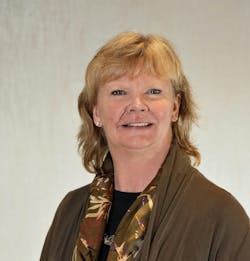Roadmap to Attract and Retain Women in Supply Chain Careers
One day in the near future, there won’t be a need to read this type of article.
Parity in supply chain careers will have been achieved and there will be as many women holding influential positions as men.
There is reason to believe that this will occur sooner than later. According to Gartner data, in 2023, 26% of supply chain C-suite roles were filled by women. That number is at an all-time high and up from 19% in 2022.
So how does the sector keep pushing forward? MH&L turned to Pamela Dow, who is currently chair of the Association for Supply Chain Management (ASCM) board. In her 38-year career in supply chain management she has been influential in designing processes and metrics at companies such as TRW, Johnson Controls and Tenneco. She has thrived facing business challenges in different markets. And she has also faced challenges often being the only woman in the room.
Talking with her about her career, a roadmap of how to bring more women into the field and how to keep them, emerged. This article will cover that roadmap from attracting to retaining women as well some advice from Dow on the particular concerns women face and ideas on how to address them.
To Attract Women to Field, Explain Value of Role to Organization
One of the challenges of presenting supply chain management as a career is that it’s difficult to define. There are so many departments that fall within the sector -- procurement, material handling, production management, logistics, scheduling, transportation, integrated business planning, information technology and operations management. Bringing all of these functions together in a simple package and attributing tasks performed is challenging. Furthermore, tying the contribution of these tasks to the success of the entire organization is complicated.
“When you get into logistics, operations and warehousing, the job is similar to an industrial engineer, and involves logic and process flow and problem solving,” explains Dow. “And that is where you can make this job fun. You are the one working with people in the plant and across the organization and you are closest to the customer.”
Drawing the line from this job function to an outcome that helps society is something that fits well into a supply chain career. Dow provides an example of her time at TRW. Her plant was building a sensor which would detect a crash and send a signal to the airbag which when deployed could save someone’s life. “Everyone knew the importance of how their work contributed to this end goal, and it built a strong culture. We were proud of the work we did,” says Dow.
In addition to the actual product, the environmental impact of the process is also part of a supply chain career. Ensuring a process reduces waste and improves environmental effects of production and material handling is core to this career.
In the human capital management area, a well-run warehouse for example can have a significant impact on an employee’s life. Dow provides this example from her experience. “The first thing I do is go into the warehouse and talk to the materials handling manager. That person has the pulse of what’s going on in the organization. The warehouse process affects the production process, which in turn affects employee scheduling. At one of my companies, when I was trying to implement a process that balanced out workload, I asked a warehouse employee if he liked the overtime he worked. He replied he didn’t. So, I explained that when an engineer came over to his area and took a part that was used in production and didn’t record it, the part wasn’t re-ordered and could end up changing the production schedule which would require him to work overtime. After that, every part was tagged and traced and recorded into the inventory system.”
Devise Hiring Processes with Women in Mind
These examples point out the various aspects of supply chain management that are often not clearly spelled out to a potential candidate. The problem solving, operations and management functions aren’t described during the hiring process. The candidate doesn’t get a clear picture of how this job not only provides a strong career trajectory, but on a daily basis is putting to use the skills, such as leadership, that women want and don’t often have access to.
Part of the issue is in the hiring process itself. Dow notes there are key words and messages that steer women away from jobs in the field. Using words in a job description such as aggressive, competitive driven, are perceived as more masculine traits, and don’t always appeal to women.
The true solution is to use objective metrics to evaluate candidates. Dow used this method when she chose candidates. “I always used the Kepner-Tregoe decision analysis which is a framework on how to define the objectives and skills required to make the hiring decision selection in the areas of leadership, technical, communication, teamwork and personal work standards. I applied these four skills to a candidate: situation appraisal, problem analysis, decision analysis and potential problem analysis. I then put this information in a document that did not include names and evaluated the skills and experiences side by side to select the strongest in each area. The candidate with the most strength areas was selected.” Metrics like these can eliminate gender bias and level the playing field.
There also needs to be changes when it comes to leadership perception. “Leadership needs to understand the supply chain organization and functions,” says Dow. And supply chain managers must understand how to make the business case for a well-run supply chain organization with efficient processes. Throughout her career, Dow found herself creating many processes but sometimes those processes stayed in the business unit and didn’t become systematic throughout the company. As the owner of the process, it can become frustrating. And that frustration can lead to poor retention.
Retention through Strong Culture and Career Planning
A culture that undervalues women’s contributions, either through the above- mentioned lack of recognizing the value of work done in the supply chain, or through lack of promotions is not conducive to retention. Dow mentions that in times in her career she had to “fight” to get promotions that she had earned. This didn’t seem to happen as much to men. In fact, she cited the example of one her direct reports, a man, continually asking for a raise. She ended up giving him the raise for fear of losing him. She didn’t see that type of behavior from women.
“We need to mentor women in our organizations and teach them how to communicate the value that they provide,” says Dow. “We also need to teach them how to negotiate, clearly state their accomplishments, go after what they want and accept challenges. In my career I was a supervisor at 27 and a manager at 28. I had mentors encouraging me to take risks, and move into larger roles.”
Different communication styles between men and woman can also cause some incorrect perceptions. Dow said she had found that women tend to ask more questions but that is perceived negatively by many men signaling that women don’t have the necessary knowledge for the job. “That simply isn’t the case,” says Dow. “Women are more upfront about learning, whereas men might ask the same question, but in private, after the meeting.” Recognizing the different forms of communication can alleviate incorrect conclusions.
Also playing into positive retention is the ability to understand the expectations of the job and its effect on your career. Dow found that upward movement was difficult when there was not a clear explanation of what was expected of her. Companies can mitigate this by providing clear career paths with roles and responsibilities spelled out and measured. Objective measurements can help reduce any unconscious bias as to the abilities of women.
Helping women plan a career track within the organization is also key to retention. And it’s something that continually shows up in surveys of employees as to why they stay at an organization. Creating a solid career path can include initial internships and rotations.
“Getting in on the ground floor, working at the plants and understanding all of the variables that goes into a supply chain management career is essential to laying a foundation upon which a successful career is built. It takes time and sacrifice, but I have always found it’s worth the effort. The more educated I am about all aspects of the job and its impact on the organization as a whole, the more effective and valuable I became.”
Continuing education about the field and the various functions in the supply chain organization is a driving factor as to why Dow is now involved with ASCM. Companies can identify women within their organization who might be a good fit for their supply chain management organization and ASCM has a variety of resources to help including:
· Supply Chain Knowledge Center — Includes on-demand learnings, standards and tools, group posts and discussions, job board, and more.
· Certified in Transformation for Supply Chain (CTSC) – The CTSC equips supply chain professionals responsible for driving transformation with a collected group of best practices, knowledge, skills, and abilities to initiate and enact supply chain transformation.
· Supply Chain Warehousing Certificate — signifies the completion of a foundational education program designed to help individuals build their knowledge in warehousing and distribution.
· Certified in Logistics, Transportation and Distribution (CLTD)
Dow’s experience in the field and the opportunities she had to tackle issues, work with teams and provide solutions through processes has allowed her not only to enjoy her time in the career, but to contribute to the growth of companies she worked for and the field in general. “I would like see more undergraduate programs in this area offered to woman as the first step into the entry to the field, and when they land jobs, they can make take control of the positions through their individual abilities.” she says. “It’s an exciting career for women.”

